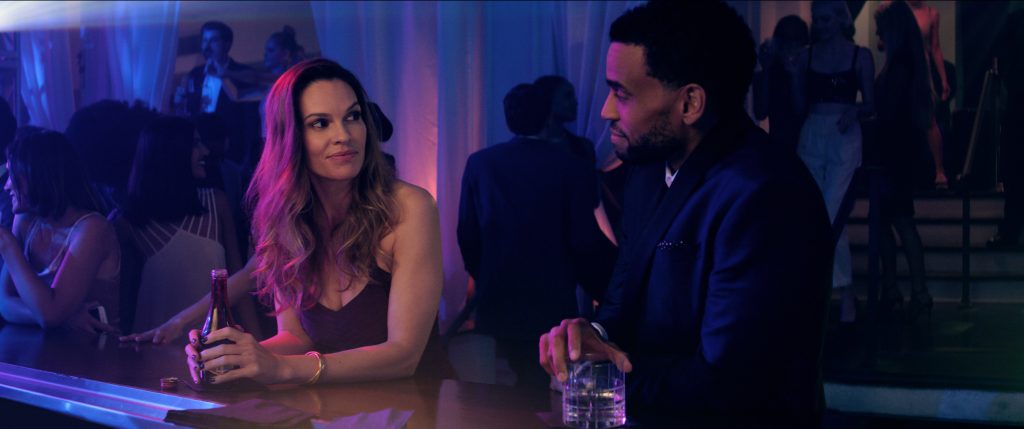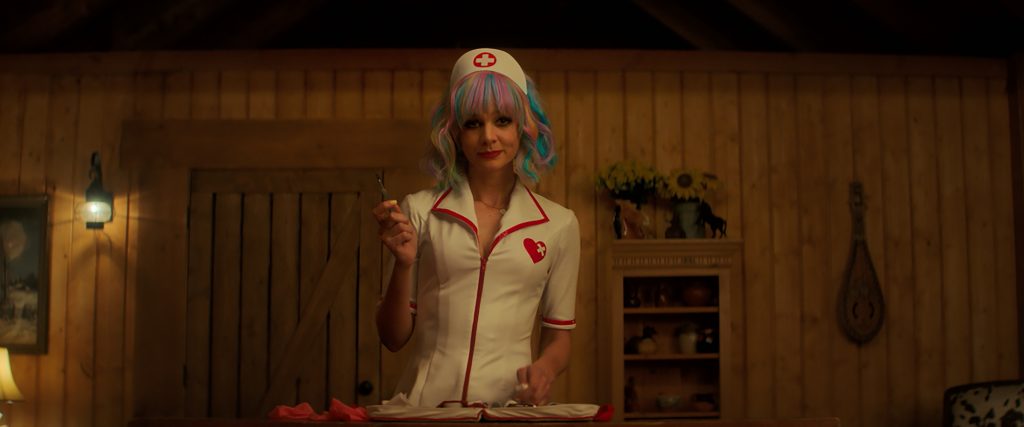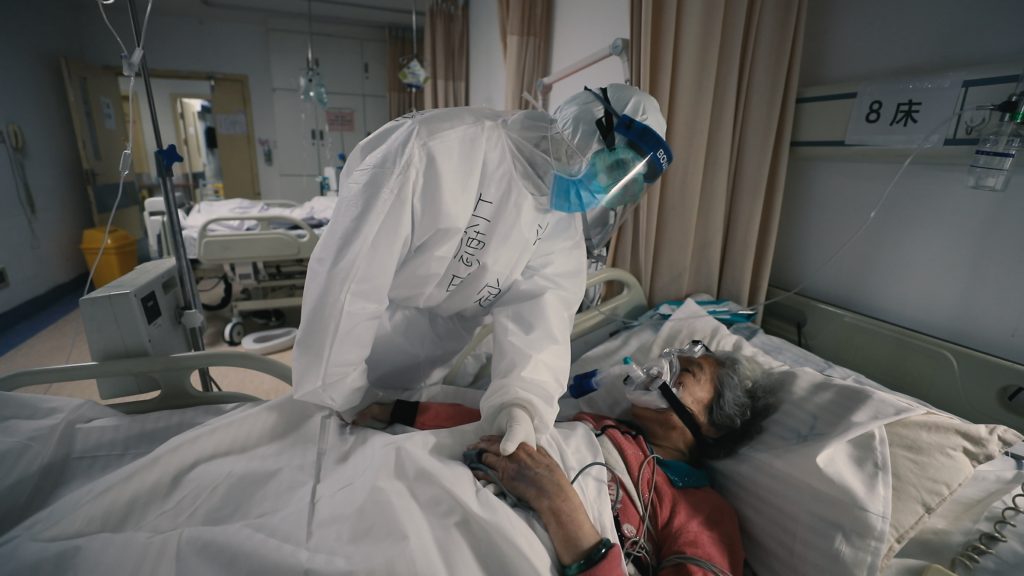December 27, 2020
by Carla Hay

Directed by Deon Taylor
Culture Representation: Taking place in Los Angeles and briefly in Las Vegas, the dramatic thriller “Fatale” features a racially diverse cast (African Americans and white people, with some Asians and Latinos) representing the middle-class.
Culture Clash: After a married man has a one-night stand with a woman he met at a nightclub in Las Vegas, he’s shocked to find out that the woman is a police officer who now wants to make his life hell.
Culture Audience: “Fatale” will appeal primarily to people who like watching cheap, inferior ripoffs of “Fatal Attraction.”

If Tyler Perry wanted to make his own version of 1987’s “Fatal Attraction,” it would look a lot like “Fatale.” Here’s the checklist, just so you know. Is there a married couple having relationship problems in the movie? Check. Did the husband cheat on the wife? Check. Is there a completely ludicrous plot twist in the story? Check.
Deon Taylor actually directed “Fatale,” whose uninspired screenplay was written by David Loughery. And even though “Fatale” has an Oscar winner (Hilary Swank) in its cast, it still doesn’t give any class to this completely tacky thriller. (Taylor and Swank are two of the producers of “Fatale.”) Everything about “Fatale” looks like it was made for a TV network or streaming service instead of for cinemas, where people have to pay money to see this substandard schlock that is “Fatale” in its initial release.
“Fatale” uses the same template of “Fatal Attraction,” except that it adds an element that could have been very intriguing: The psycho mistress is a cop. However, “Fatale” bungles that aspect of the story by having the cop do a lot of things that she would be very unlikely to get away with so easily in real life.
The movie starts out by showing sports agent Derrick Taylor (played by Michael Ealy) driving in his car somewhere in Los Angeles, where he lives. Derrick says in a cringeworthy voiceover narration: “I was always the smart one, the one who played to win. I was damn good at it and was the best. Then I took my eye off of the ball. And just like that, the rules of the game changed. I was no longer playing to win. This was a new game. I’m playing for my life now.”
Translation: “I went to Vegas, cheated on my wife, and now the psycho I slept with won’t leave me alone and might kill me.”
Before viewers get to that predictable point in the story, it’s shown that Derrick and his wife Traci (played by Damaris Lewis) are stuck in a marital rut. Derrick (who’s in his 40s) and Traci (who’s about 15 years younger than Derrick) do not have children, and the spouses have both been working long hours and haven’t been spending a lot of time together. When they do spend time together, Derrick and Traci don’t seem to like each other very much. The romantic passion they once had is in danger of leaving their marriage permanently.
Derrick has a successful sports agency called Vista Entertainment, which he co-founded with his best friend Rafe Grimes (played by Mike Colter), who is thinking about cashing out to become an instant multimillionaire. It’s revealed later in the story that talent agency giant William Morris Endeavor (WME) has been eyeing Vista for a corporate buyout. Rafe thinks that he and Derrick should take the offer if it comes. Derrick doesn’t want to sell the company, and it’s in Derrick and Rafe’s contract with each other that Vista won’t be sold unless they both agree to it.
Rafe is an extroverted bachelor who is dating a woman named Micaela (played by Kali Hawk), and the relationship seems to be going well. While Rafe and Micaela are visiting Derrick and Traci in their home, the two couples have drinks together and make small talk that’s pleasant but superficial. However, Traci is noticeably cold to Derrick.
One day, Derrick and Traci have a tense conversation because she stayed out past midnight the night before, without telling him where she was. During this discussion, Traci says that she was celebrating with some clients and didn’t want to be rude by going home early. Derrick accepts that excuse, but he expresses concern over how much her career seems to be taking time away from their relationship. Traci accuses Derrick of having a double standard because his job is also demanding, but she doesn’t complain about it as much as he complains about the time she spends on her job.
By the time Derrick and Rafe travel to Las Vegas for a bachelor party of a mutual friend, Derrick and Traci’s relationship has reached a stalemate. At the nightclub where the party is held, Derrick confides in Rafe by telling him that he and Traci used to have a “perfect marriage,” but now they feel like “strangers” to each other. Rafe’s response is to tell Derrick to take off his wedding ring and pretend “for the next 24 hours, you’re a single man.”
It doesn’t take long for Derrick to act on that advice. At the nightclub, he spots a woman (played by Swank), who’s around his age and who seems to be having a good time on the dance floor. When she sits down at the bar by herself, Derrick notices the woman rebuff the advances of a man who somewhat aggressively approaches her.
Derrick decides he’ll strike up a conversation with her and see what happens. He leans in close, in a way that makes it obvious that he finds her attractive. The woman, who introduces herself as Val, comments about the man she rejected: “It’s Vegas. It brings out the predators.” Derrick replies, “And the clowns.”
Derrick and Val have some drinks together. At one point, he accidentally spills his drink on Val because someone standing next to Derrick accidentally bumped into him. Derrick makes a sheepish apology. And when he grabs a napkin to give to Val, she suggestively tells him that he can wipe off the drink himself since he made the mess. It’s an excuse for Derrick to gently rub Val near her cleavage area. Judging by the smirk on her face, she enjoys it.
Derrick tells Val that he’s at the nightclub for a bachelor party, but he lies by telling Val that his name is Darren Johnson and that he’s visiting from Seattle. Val says that she’s in Vegas by herself because she has a high-stress job and she goes to Vegas to relieve the stress. “I let myself go insane,” she tells Derrick. “I highly recommend it.”
Val asks Derrick to dance, and they start dancing suggestively on the dance floor. One thing leads to another. They kiss passionately and end up having sex in Val’s hotel room. The next morning is the first sign that something is “off” with Val. While Derrick gets dressed and is ready to leave, he notices that he can’t find his phone. Val tells Derrick that she locked his phone in the room’s safe.
Derrick asks Val to give him his phone because he doesn’t want to miss his plane flight at the airport. Val refuses to give him the combination to the safe until he has sex with her again. “What? You want me to fuck it out of you?” Derrick says to Val about the safe’s combination, as he decides to give her what she wants.
Back in Los Angeles, Derrick thinks that Val is just a one-night stand he’ll never see again. The fling seems to have boosted his sexual confidence, because now he’s acting like a romantic and attentive husband to Traci. She comes home one evening and is surprised to find out that Derrick has made dinner for her. The passion in their marriage is rekindled and things seem to be getting back on track for Derrick and Traci.
But there would be no “Fatale” movie if it had a happy ending right there. One night, while Derrick and Traci are in the middle of having sex in their bedroom, they hear noises inside their house. It’s a masked man who’s an intruder with a gun. When Derrick goes to investigate the noise, a scuffle breaks out between the intruder and Derrick that causes Derrick to be slightly injured. And the intruder escapes without taking anything.
Derrick and Traci call 911. And guess who’s the police detective who shows up at the house to interview the couple and lead the investigation into the crime? It’s Detective Valerie Quinlan, also known as Val, the same woman who had the fling with Derrick in Las Vegas. Derrick and Val are shocked to see each other, but they play it cool and act as if they’ve met for the first time.
However, Val messes with Derrick a little bit when she asks him in front of Traci: “Do I know you?” Traci tells Val that Val probably recognizes Derrick from seeing him on TV. Traci explains that Derrick used to be a college basketball star. He’s also been interviewed on TV because of his work as a sports agent. Val pretends to accept the explanation, but gives Derrick a knowing look, as if to say, “Don’t mess with me or I’ll tell our secret to your wife.”
Because of this investigation, Val finds out that Derrick not only lied to her about his name and the city where he lives, but he also lied about being married. During their tryst in Las Vegas, Val showed signs of being unreasonable and controlling. And now that she found out that Derrick lied to her, she doesn’t take it lightly. She’s going to get revenge.
The rest of “Fatale” is basically what you might expect from a movie that borrows heavily from “Fatal Attraction,” with a mentally unbalanced scorned woman acting out in twisted ways to get revenge on the man she feels did her wrong. It’s shown that Val has a very troubled past as an alcoholic who lost custody of her daughter Haley (played by Oakley Bull), who is now 7 or 8 years old.
A flashback reveals that the incident that caused Val to lose custody of Haley happened about three years ago, when Val was passed out drunk and left her daughter in the room with a loaded gun that had its safety off. Haley picked up the gun and fired it. Luckily, no one was hurt, but Val’s ex-husband Carter Haywood (played by Danny Pino) was upset enough to ask for and get full custody of Haley. Val doesn’t even have visitation rights to Haley.
Carter is now married to another woman (played by Lexa Gluck), and he has a restraining order against Val. You can imagine what Val did to get that restraining order against her. At one point in the story, Val says that she’s been sober for the last three years, with the implication being that the gun incident with Haley motivated Val to get sober. However, when it comes to Val, sobriety doesn’t equal sanity.
Carter is no angel either. In the beginning of the movie, a TV news report shows that he’s a politician in Los Angeles who’s been accused of siphoning funds from the South Central Urban Renewal Project. Let’s see: There’s a possibly corrupt politician who’s got a vengeful ex-wife who’s become more unhinged now that she feels humiliated by a one-night stand who wants nothing to do with her. What could possibly go wrong?
There’s another character who plays a role in the messy drama that ends up happening as the story unfolds. Tyrin Abernathy (played by Tyrin Turner) is Derrick’s cousin who has a shady past. Derrick has been like a mentor to Tyrin. It’s implied that Tyrin has been in trouble with the law, but Derrick has helped Tyrin clean up his act. Tyrin helps Derrick by doing errands for him and looking out for Derrick’s widowed mother Valeria (played by Denise Dowse), who has a close relationship with Derrick.
However, Rafe doesn’t completely trust Tyrin and doesn’t like it when Tyrin comes to the Vista office to visit Derrick. Apparently, Tyrin is too “ghetto” for Rafe, who thinks that Tyrin hanging out at the office isn’t good for the upscale company image that Rafe wants to project. Derrick thinks that Rafe is judging Tyrin too harshly.
“Fatale” piles on some plot twists, some of which are more believable than others. What’s unintentionally hilarious about the movie is that every time something bad happens to Derrick, Val seems to be the only cop in the big city of Los Angeles who just happens to be called to the scene and who investigates. She’s not a high-ranking officer, so in the real world, she wouldn’t have the clout to be involved with so many separate incidents that involve Derrick. And if she did have the clout, it would raise suspicions with her colleagues why she keeps showing up in Derrick’s life on “police business.”
There are double-crosses and other betrayals that become increasingly ridiculous and play out like a very cheesy soap opera. As far as villains go, Swank’s portrayal of Val isn’t terrible, but it’s very generic. Ealy and most of the rest of the cast turn in very mediocre performances, except for Lewis who is downright awful with her wooden acting.
Taylor’s direction of “Fatale” is pedestrian and looks every bit like the low-budget tawdry thriller that it is. (Taylor and Ealy previously worked together on the 2019’s “The Intruder,” a second-rate and predictable thriller in which Ealy plays a married man stalked by a vengeful psycho, played by Dennis Quaid, because of jealousy over home ownership.) “Fatale” really is not much different from a basic cable TV-movie covering the same subject matter, except that “Fatale” has fouler language and sex scenes that are more suggestive than what’s on basic cable. Just like low-quality counterfeit merchandise that ends up falling apart, “Fatale” is a flimsy and forgettable rehash of the formula that made “Fatal Attraction” a classic.
Lionsgate released “Fatale” in U.S. cinemas on December 18, 2020. The movie’s VOD release date is January 8, 2021.


















